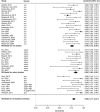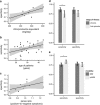Detecting neuroimaging biomarkers for schizophrenia: a meta-analysis of multivariate pattern recognition studies
- PMID: 25601228
- PMCID: PMC4915258
- DOI: 10.1038/npp.2015.22
Detecting neuroimaging biomarkers for schizophrenia: a meta-analysis of multivariate pattern recognition studies
Abstract
Multivariate pattern recognition approaches have recently facilitated the search for reliable neuroimaging-based biomarkers in psychiatric disorders such as schizophrenia. By taking into account the multivariate nature of brain functional and structural changes as well as their distributed localization across the whole brain, they overcome drawbacks of traditional univariate approaches. To evaluate the overall reliability of neuroimaging-based biomarkers, we conducted a comprehensive literature search to identify all studies that used multivariate pattern recognition to identify patterns of brain alterations that differentiate patients with schizophrenia from healthy controls. A bivariate random-effects meta-analytic model was implemented to investigate the sensitivity and specificity across studies as well as to assess the robustness to potentially confounding variables. In the total sample of n=38 studies (1602 patients and 1637 healthy controls), patients were differentiated from controls with a sensitivity of 80.3% (95% CI: 76.7-83.5%) and a specificity of 80.3% (95% CI: 76.9-83.3%). Analysis of neuroimaging modality indicated higher sensitivity (84.46%, 95% CI: 79.9-88.2%) and similar specificity (76.9%, 95% CI: 71.3-81.6%) of rsfMRI studies as compared with structural MRI studies (sensitivity: 76.4%, 95% CI: 71.9-80.4%, specificity of 79.0%, 95% CI: 74.6-82.8%). Moderator analysis identified significant effects of age (p=0.029), imaging modality (p=0.019), and disease stage (p=0.025) on sensitivity as well as of positive-to-negative symptom ratio (p=0.022) and antipsychotic medication (p=0.016) on specificity. Our results underline the utility of multivariate pattern recognition approaches for the identification of reliable neuroimaging-based biomarkers. Despite the clinical heterogeneity of the schizophrenia phenotype, brain functional and structural alterations differentiate schizophrenic patients from healthy controls with 80% sensitivity and specificity.
Figures




References
-
- Borgwardt S, Fusar-Poli P (2012). Third-generation neuroimaging in early schizophrenia: translating research evidence into clinical utility. Br J Psychiatry 200: 270–272. - PubMed
-
- Bose SK, Turkheimer FE, Howes OD, Mehta MA, Cunliffe R, Stokes PR et al (2008). Classification of schizophrenic patients and healthy controls using [18 F] fluorodopa PET imaging. Schizophr Res 106: 148–155. - PubMed
Publication types
MeSH terms
Substances
LinkOut - more resources
Full Text Sources
Other Literature Sources
Medical

